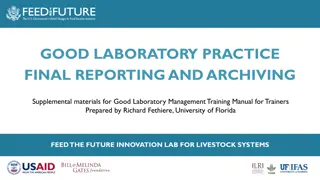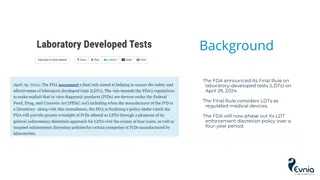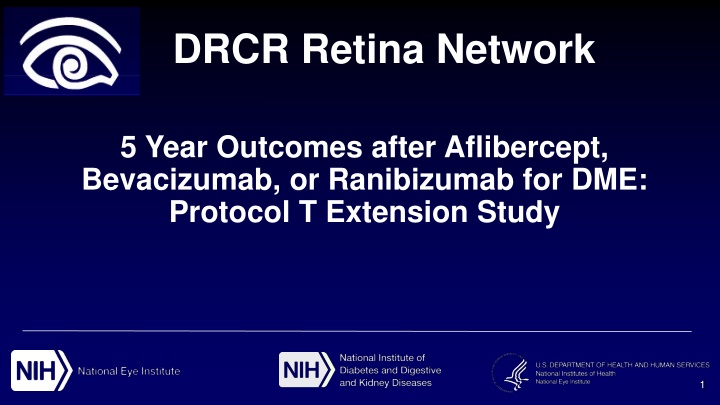
Outcomes of Aflibercept, Bevacizumab, or Ranibizumab for DME: 5-Year Study Results
"Explore the 5-year outcomes of Aflibercept, Bevacizumab, and Ranibizumab for Diabetic Macular Edema in a randomized clinical trial. Learn about visual acuity changes, treatment courses, and management strategies post-protocol. Findings shed light on long-term effectiveness and patient care considerations."
Download Presentation

Please find below an Image/Link to download the presentation.
The content on the website is provided AS IS for your information and personal use only. It may not be sold, licensed, or shared on other websites without obtaining consent from the author. If you encounter any issues during the download, it is possible that the publisher has removed the file from their server.
You are allowed to download the files provided on this website for personal or commercial use, subject to the condition that they are used lawfully. All files are the property of their respective owners.
The content on the website is provided AS IS for your information and personal use only. It may not be sold, licensed, or shared on other websites without obtaining consent from the author.
E N D
Presentation Transcript
DRCR Retina Network 5 Year Outcomes after Aflibercept, Bevacizumab, or Ranibizumab for DME: Protocol T Extension Study 1
Protocol T - Study Design Randomized Multi-center Clinical Trial (N = 660) 18 years old with type 1 or type 2 diabetes Center-involved DME on OCT VA letter score 20/32 to 20/320 No or minimal prior treatment for DME Aflibercept Bevacizumab Ranibizumab 2
Mean Change in VA Over 2 Years Baseline Visual Acuity 20/50 or Worse ~50% of Cohort Baseline Visual Acuity 20/32 to 20/40 20 20 ~50% of Cohort Mean Change in Visual Acuity Letter Score 18 18 16 16 14 14 12 12 10 10 8 8 6 6 4 4 2 2 0 0 Baseline 1-Year 2-Year 2-Year Baseline 1-Year Visit Visit Aflibercept Bevacizumab Ranibizumab 3
T Extension - Methods Protocol T participants return for 5-year visit (3 years after Protocol T ended) DME and diabetic retinopathy management at clinician discretion (not part of a study) between years 2 and 5 At 5 year visit: Ocular and medical history was solicited Medical records were reviewed Visual acuity, eye exam, OCT, color photos obtained 4
T Extension - Objectives Primary Objective: For the 3 years after Protocol T was stopped, provide information on: Treatment Course Visual Acuity DME Main objectives do NOT include comparing treatment groups after 2 years Management at clinician discretion Did participants continue care with a Retina Specialist? and how often? baseline and between the 2 year visit and 5-years? the 2 year visit and 5-years? What treatments have been given How did participant VA change from How did participant CST change from Baseline and between How many eyes still have DME at 5 years? Data may be confounded by clinicians and patients awareness of treatment group and Protocol T results 5
Eligibility and Participation Eligible for T Extension N Patients = 558 Participant N Patients = 317 68%* Non-Participant N Patients = 146 32%* Died after Protocol T N Patients = 95 * Excluding deaths
Ocular Characteristics Participants vs. Non- Participants Non- Participant Participant* Baseline Randomized Treatment Group Aflibercept Bevacizumab Ranibizumab Mean VA Letter Score Mean OCT CST, m 2-Year Mean VA Letter Score Mean OCT CST, m N = 158 N = 317 34% 33% 34% 36% 30% 33% P=0.81 62 (20/63) 419 N = 124 74 (20/32) 256 66 (20/50) 413 N = 312 78 (20/32) 252 P<.001 P=0.53 P=.03 P=0.86 7 * Excludes deaths
1 Retinal Exam Since Protocol T 100% ~98% of Visits Occurred at Protocol T Clinical Site Overall Aflibercept Bevacizumab Ranibizumab 50% 97% 96% 95% 92% Mean Number of Visits Per Participant (between 2-5 years): ~14 0% Overall N = 317 Aflibercept Bevacizumab Ranibizumab N = 115 N = 96 N = 106 8
Treatments Since Protocol T 100% 80% 60% 40% 70% 20% 38% 32% 19% 10% 10% 8% 0% Aflibercept Bevacizumab Ranibizumab Corticosteroid Focal/Grid Laser PRP 1 Treatment for DME or DR At Least One Treatment 9
Anti-VEGF Treatments Since Protocol T 100% 17% 16% 19% 25% 6% 80% 11% 51% 45% 10% 17% 12% Multiple anti-VEGF Agents Ranibizumab Only Bevacizumab Only Aflibercept Only None 19% 18% 60% 18% 31% 22% 22% 40% 12% 61% 20% 33% 32% 32% 30% 0% All Aflibercept N = 115 Bevacizumab Ranibizumab N = 96 N = 317 N = 106 10 Percentage not receiving alternative anti-VEGF
Distribution of Anti-VEGF Injections Received After 2-Years Median Number of Injections: 4 35% 2% 30% 25% 32% Participants (%) 1% 20% 15% 0% 10% 20 21 22 23 24 25 26 27 28 29 30 31 32 5% 0% 0 1 2 3 4 5 6 7 8 9 10 11 12 13 14 15 16 17 18 19 20 21 22 23 24 25 26 27 28 29 30 31 32 Injections After Last Trial Visit (No.) N = 317 11
Mean Change in VA Over 5 Years Overall 25 Mean Change in Visual Acuity Letter Score Observational Study Randomized Trial 20 15 5-Year Mean Change: 7.4 letters 95% CI: (5.9, 9.0) +12.2 10 +7.4 Mean Change between 2 and 5 Years: -4.7 letters 95% CI: (-6.0, -3.3) 5 0 Baseline N = 317 2- Year N = 312 1- Year N = 315 5- Year N = 312 13
Mean Change in VA Over 5 Years Full Cohort 25 Mean Change in Visual Acuity Letter Score Observational Study Randomized Trial 20 Overall Aflibercept Bevacizumab Ranibizumab +14.0 15 +7.6 +8.0 +12.4 +10.0 10 5 +6.6 0 1- Year 2- Year 5- Year N = 112 N = 96 N = 104 N = 115 N = 96 N = 106 N = 112 N = 94 N = 106
Mean Change in VA Over 5 Years Baseline VA 20/32 to 20/40 Baseline VA 20/50 or Worse 25 25 Mean Change in Visual Acuity Letter Score 20 20 15 15 10 10 5 5 0 0 Baseline 2-Year Baseline 2-Year 5-Year 5-Year Visit Visit 15 Overall Aflibercept Bevacizumab Ranibizumab
Baseline, 1, 2 and 5 Year VA 100% 80% 47% 51% 52% 57% Participants (%) 60% 20/25 or better 20/32 - 20/40 20/50 - 20/160 20/200 or worse 40% 27% 32% 27% 45% 20% 21% 14% 15% 0% Baseline N = 317 1-year N = 315 2-year N = 312 5-year N = 312 Visit Year
Mean Change in OCT CST Over 5 Years 25 Full Cohort Observational Study Randomized Trial -25 Mean Change in OCT CST (m ) 5-Year Mean Change: -154 m 95% CI: (-166 to -142) -75 -125 -156 m -154 m Mean Change between 2 and 5 Years: - 1 m, 95% CI: (-12 to 9) -175 -225 1- Year N = 313 2- Year N = 310 5- Year N = 313 Baseline N = 313 22
Mean Change in OCT CST Over 5 Years Full Cohort 25 Observational Study Randomized Trial -25 Mean Change in OCT CST (m ) Overall Aflibercept Bevacizumab Ranibizumab -75 -131 -150 -125 -150 -153 -175 -161 -181 -225 5- Year N = 113 N = 95 N = 105 Baseline 2- Year N = 111 N = 93 N = 106 1- Year N = 113 N = 95 N = 105
Baseline, 1, 2 and 5 Year OCT CST* 100% Percent of Participants 80% 53% 52% 59% 62% 60% <250 m 250 to 400 m 400 m 40% 37% 34% 46% 30% 20% 11% 8% 7% 0% Baseline N = 313 1 Year N = 313 2 Year N = 310 5 Year N = 313 *Stratus Equivalent 24
Limitations Only 2/3 of eligible participants completed 5-year visit Baseline visual acuity and 2-year visual acuity better for participants who completed 5-years than those who didn t Treatment from 2-5 years at investigator discretion Cannot compare treatment groups after 2 years Treatment data collection after 2 years was retrospective 25
Conclusion After Protocol T ended and patients had standard care: 95% of patients received retinal care and 68% received at least 1 anti-VEGF injection On average patients demonstrated visual gains from baseline, but mean visual acuity worsened between 2 and 5 years No significant changes in central subfield thickness were seen between 2 and 5 years Results differ from prior clinical trials in DME that have demonstrated better maintenance of VA gains (e.g. Protocol I) Strategies to improve long-term visual outcomes in clinical care among eyes with DME are needed 26
Thank you! 27

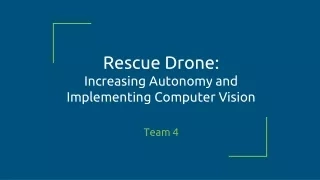
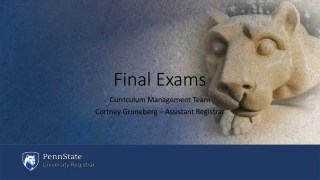
![READ⚡[PDF]✔ Yup I'm Dead...Now What? The Deluxe Edition: A Guide to My Life Info](/thumb/20463/read-pdf-yup-i-m-dead-now-what-the-deluxe-edition-a-guide-to-my-life-info.jpg)



